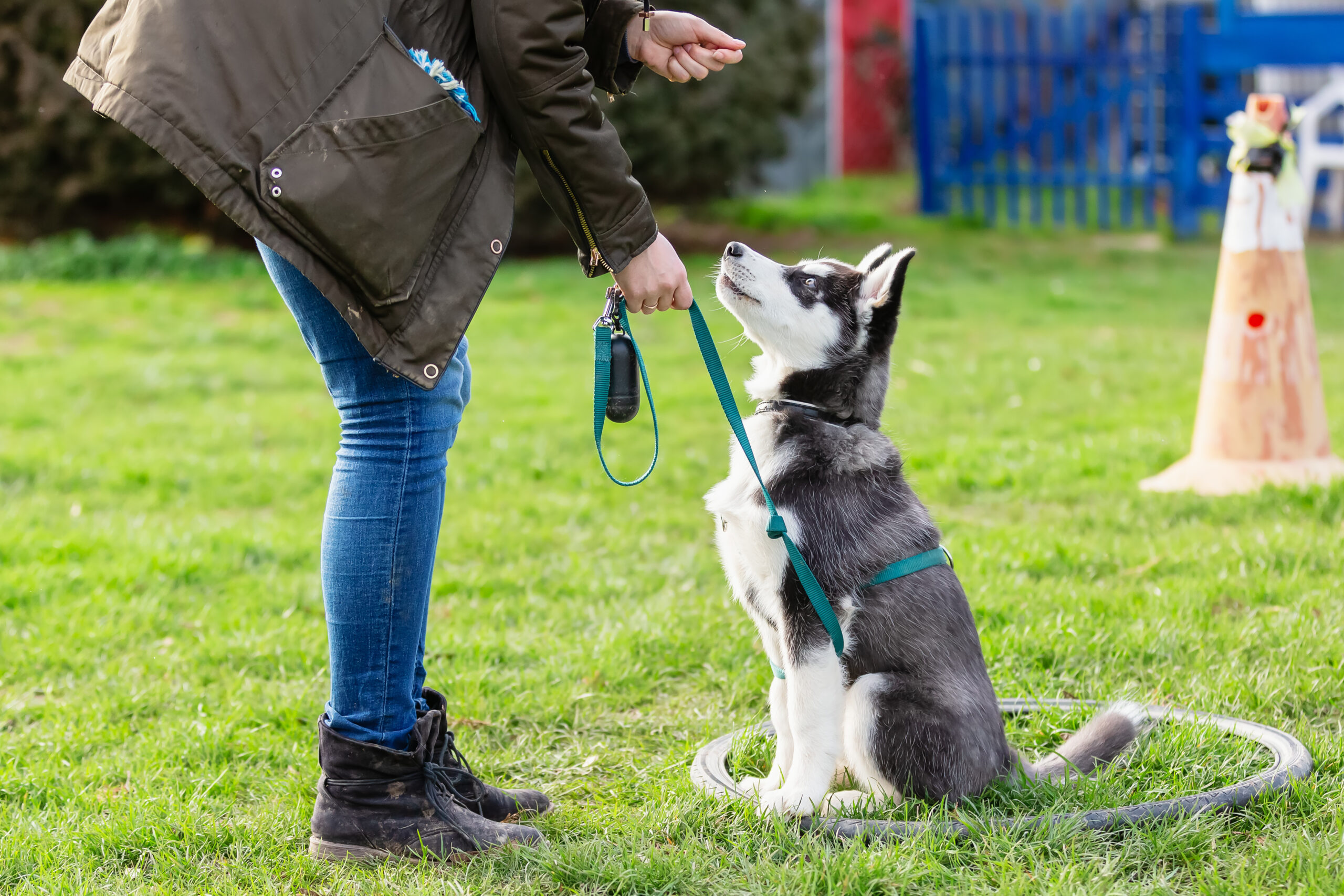Dog Training Near Me: Success Stories from Real Pet Owners
A Novice's Journey Into the World of Pet Training: Secret Insights and Approaches
A novice's journey right into dog training commonly reveals a complex interplay of comprehending canine behavior and efficient interaction methods. New instructors swiftly find the significance of positive reinforcement and the demand for uniformity in their technique. As they browse via vital commands and socialization, challenges might arise. These experiences can test their persistence, yet they also existing chances for development. What understandings will become they challenge usual challenges and build a stronger bond with their pet dogs?
Comprehending Your Pet dog's Actions
How can a canine's actions reveal its mood? Comprehending canine actions is important for effective training and constructing a strong bond. Dogs communicate with body language, vocalizations, and actions, each offering understanding right into their sensations. A wagging tail commonly indicates joy, while a reduced tail may indicate anxiety or submission.
Similarly, a dog that barks excessively might be expressing anxiousness or exhilaration, while an unwinded pose recommends convenience and contentment. Observing these behaviors helps proprietors react properly, fostering a supportive atmosphere. Additionally, behaviors such as pacing or excessive licking can suggest anxiety or discomfort, signaling a need for treatment.
Recognizing these psychological signs allows pet dog proprietors to customize their training approaches, guaranteeing that they resolve their dog's details requirements. By understanding their psychological states, proprietors can support a relying on relationship, inevitably leading to even more successful training end results.
Necessary Training Tools and Tools
A variety of essential training tools and devices can markedly enhance the dog training experience. Novices usually discover that a well-fitted collar or harness is important for guaranteeing both comfort and control throughout training sessions. Chains, ideally 4 to 6 feet long, give the required advice while enabling for flexibility of movement. Remote controls function as efficient tools for marking desired actions, facilitating more clear communication in between the instructor and the canine.
Additionally, treat pouches can improve the process of rewarding etiquette, maintaining treats available. Training floor coverings or marked areas assist establish boundaries, encouraging focus during lessons. Toys that promote engagement, like yank playthings or bring balls, can also be employed to reinforce training purposes. Overall, selecting the suitable tools not only help in effective training however additionally cultivates a favorable environment, making the training journey pleasurable for both the canine and the trainer.
Favorable Support Strategies
Positive reinforcement strategies are widely recognized as reliable methods for encouraging preferred habits in dogs. These methods entail awarding a dog for particular actions, strengthening the chance of those actions being duplicated. Common incentives consist of treats, praise, or playtime, all of which offer to motivate the pet dog positively. Timing is crucial; incentives ought to be offered immediately after the desired habits to develop a solid organization.
Consistency is also crucial; utilizing the very same signs and rewards assists the pet dog comprehend what is expected. In addition, differing the benefits can preserve a pet dog's passion and enthusiasm throughout training sessions. Positive reinforcement not just boosts obedience but additionally cultivates a trusting bond between the canine and the instructor. This method contrasts sharply with punitive techniques, advertising an extra productive and enjoyable training experience. Overall, positive support offers as a fundamental aspect in effective pet training approaches.
Standard Commands Every Pet Dog Need To Know
Basic commands form the foundation of reliable interaction between a pet and its owner. Mastering standard commands such as "rest," "stay," "come," "down," and "leave it" is critical for establishing a well-behaved pet (Dog Training Near Me). These commands not only ensure safety yet likewise foster excellent manners in numerous situations
The command "sit" works as a fundamental foundation, promoting persistence and emphasis. "Keep" enhances self-discipline, permitting pet dogs to stay fixed till given more guidelines. "Come" is necessary for recall, making sure pets return quickly when called. The "down" command aids in relaxing an ecstatic pet, while "leave it" shows them to disregard diversions, improving their safety and security in day-to-day environments.
Training these commands with positive reinforcement, such as treats and praise, encourages canines to discover and respond willingly. Regular practice and patience are essential, leading the way for a harmonious partnership between the dog and its owner.
Socialization: The Key to a Well-Adjusted Dog
Socialization is vital for establishing a well-adjusted dog, as it emphasizes the relevance of early exposure to different environments and experiences. Making use of positive interaction methods can greatly enhance a pet dog's ability to adjust and prosper in different social settings. Acknowledging the signs of effective socializing is crucial for owners to analyze their pet's development and total wellness.
Significance of Early Direct Exposure
When young puppies are exposed to a selection of individuals, environments, and experiences during their developmental months, they are more probable to become well-adjusted grown-up pet dogs. Early direct exposure is important as it assists young puppies find out to navigate different situations, lowering anxiety and anxiousness in novel scenarios. Socializing cultivates self-confidence, permitting canines to interact positively with other animals and people. The lack of such experiences can bring about behavioral concerns, such as hostility or too much shyness. By introducing pups to different stimulations-- like audios, environments, and social experiences-- owners can substantially affect their future personality and versatility. Prioritizing early direct exposure plays a necessary function in shaping a pet dog's habits, ensuring they expand right into balanced and friendly companions.
Positive Interaction Techniques
A variety of favorable communication techniques can considerably improve a dog's socialization procedure, causing a well-adjusted buddy. Participating in consistent, positive support methods aids dogs connect new experiences with fulfilling end results. Methods such as remote control training, treats, and spoken appreciation urge desired behaviors and promote self-confidence. Structured playdates with various other dogs give important social abilities, while exposure to diverse environments, sounds, and people fosters adaptability. Proprietors need to additionally exercise patience and stay calm, as a loosened up temperament can aid reduce a pet dog's anxiety throughout socialization. Normal training sessions that incorporate enjoyable and delightful tasks reinforce the bond between the owner and the canine, producing a foundation for a trusting partnership. These communications are essential for creating a well-shaped canine buddy.
Indicators of Effective Socialization
Exactly how can one recognize a well-socialized dog? A well-socialized pet dog exhibits peace and self-confidence in numerous atmospheres and around different individuals and animals. It responds favorably to new experiences, showing inquisitiveness instead than worry. When fulfilling various other click here to read dogs, a well-socialized canine involves in play or stays loosened up, avoiding aggressiveness or extreme stress and anxiety. Furthermore, such a pet demonstrates great manners, responding to commands and add varied situations. Indicators of effective socializing likewise include adaptability; the canine can change pop over to this site its actions whether in your home, in public rooms, or during travel. Generally, a well-socialized canine personifies comfort, equilibrium, and sociability, reflecting the investment in appropriate training and direct exposure during its developmental phases.
Usual Training Difficulties and Solutions

Leash Pulling Solutions
Numerous animal owners face the challenge of leash pulling, an usual habits that can make walks uncontrollable and frustrating. To resolve this problem, instructors commonly recommend a number of efficient strategies. Making use of a front-clip harness can minimize pulling by rerouting the pet dog's interest. Second, instructing the "heel" command encourages the pet to walk steadly next to the owner. When the pet stays at the owner's side can enhance this habits, consistent reinforcement with deals with or commend. Additionally, quiting and standing still whenever the pet dog pulls can teach them that moving on only occurs when they are strolling politely. Via patience and uniformity, pet owners can transform strolls into enjoyable experiences for both themselves and their pets.
Extreme Barking Management
Extreme barking can become a considerable challenge for animal owners, usually leading to aggravation and stretched partnerships with next-door neighbors. Comprehending the underlying factors for barking is important; canines might bark out of dullness, anxiousness, or a requirement for interest. To address this concern, owners must initially recognize triggers and supply psychological excitement via interactive playthings and regular exercise. Consistent training commands, such as "silent," can help reinforce preferred habits. Favorable support, consisting of deals with and appreciation, can motivate pets to remain calm. In addition, developing a structured setting with marked peaceful times can be advantageous. In a lot more serious situations, seeking advice from a professional pet dog trainer or behaviorist may be necessary to establish a tailored technique to managing extreme barking successfully.
Jumping Actions Modification
While it may seem special when a dog raises to welcome individuals, this habits can quickly come to be problematic, particularly when it is too much or undesirable. Many canine proprietors run into challenges with leaping, frequently resulting in scratched clothes or startled guests. To correct this behavior, consistent training is crucial. One efficient approach includes teaching the pet an alternate habits, such as resting when welcoming somebody. Support, through treats or appreciation, encourages the wanted activity. Additionally, anchor owners need to stay clear of providing focus when the pet leaps; instead, they need to wait for calm habits prior to engaging. Patience and consistency are vital, as jumping actions may require time to reduce, however with correct techniques, it can be efficiently taken care of.
The Significance of Uniformity and Perseverance
Uniformity and perseverance are foundational virtues in the domain name of dog training. Successful training relies upon the regular application of methods and commands, making certain that the pet recognizes assumptions. Irregular hints can bring about complication, preventing the discovering process. For example, if a trainer enables a habits one day and dissuades it the following, the dog might end up being unsure of what is acceptable.
Persistence complements uniformity, as learning requires time. Pet dogs do not realize commands or habits instantly; rep and support are important. A fitness instructor should continue to be fully commited and calm, identifying that troubles become part of the journey. Aggravation can cause unfavorable communications, hindering progress.
With regular support and the willingness to be individual, instructors cultivate a relying on relationship with their dogs. This bond not only aids in communication but also boosts the general training experience, resulting in a mannerly buddy.
Frequently Asked Questions
How much time Does It Usually Take to Train a Dog?
The duration for educating a canine differs significantly, typically ranging from weeks to several months. Factors affecting this timeline consist of the pet dog's age, breed, previous experiences, and the consistency of the training methods used.
Can I Train an Older Canine Successfully?
Training an older pet is indeed effective, though it may need perseverance and uniformity. Older canines can learn brand-new commands and habits; nonetheless, their prior experiences and practices need to be thought about during the training process.
What Are Some Indicators My Canine Is Worried Throughout Training?

Should I Utilize Remote Control Training for All Canines?
The effectiveness of clicker training varies among canines. Some react well due to favorable support, while others might not involve. Observing each dog's habits and choices is vital for determining the very best training technique.
Just how Do I Handle Interruptions Throughout Educating Procedure?
Handling distractions throughout training sessions needs patience and uniformity. Slowly introduce interruptions, benefit focus, and keep sessions short. Creating a regulated environment assists dogs learn to concentrate, improving their ability to follow commands among distractions.
A beginner's journey into pet dog training often discloses an intricate interplay of comprehending canine behavior and effective interaction strategies. A range of vital training devices and tools can substantially boost the pet dog training experience. In addition, varying the benefits can maintain a pet's passion and enthusiasm during training sessions. When satisfying other pet dogs, a well-socialized pet dog engages in play or continues to be relaxed, staying clear of hostility or extreme anxiousness. Indications of a worried pet during training consist of excessive panting, salivating, a put tail, avoidance behaviors, or an absence of focus.